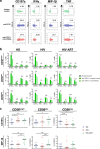CD300a inhibits CD16-mediated NK cell effector functions in HIV-1-infected patients
- PMID: 31467415
- PMCID: PMC6884514
- DOI: 10.1038/s41423-019-0275-4
CD300a inhibits CD16-mediated NK cell effector functions in HIV-1-infected patients
Conflict of interest statement
The authors declare that the research was conducted in the absence of any commercial or financial relationships that could be construed as a potential conflict of interest.
Figures

References
Publication types
MeSH terms
Substances
Grants and funding
- PI13/00889/Ministry of Economy and Competitiveness | Instituto de Salud Carlos III (Institute of Health Carlos III)
- CD17/0128/Ministry of Economy and Competitiveness | Instituto de Salud Carlos III (Institute of Health Carlos III)
- CIG 631674/EC | EC Seventh Framework Programm | FP7 People: Marie-Curie Actions (FP7-PEOPLE - Specific Programme "People" Implementing the Seventh Framework Programme of the European Community for Research, Technological Development and Demonstration Activities (2007 to 2013))
LinkOut - more resources
Full Text Sources
Medical

